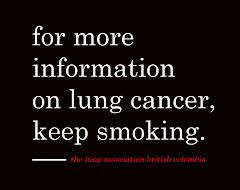It is a link to a youtube video of an fear inducing commercial where there is a little kid who lost his mom. The kid is really scared and starts crying because he lost his mom. I htink the commercial works for both young people and also adults because youngsters do not want to lose their family members but also it works for adults because they do not want to die and leave their children b themselves.
Personally I know a friend who lost his mom because of smoking and I would wish that feeling to anyone.
2nd Message- Distractor
This is a picture of an anti-smoking campaing. These pictures are really explicit and it clearly shows what can happen to a person if he or she does not stop smoking. If a person sees this I think it would stop smoking.
3rd Message- Central Route Processing Message
This is a woman who had the opportunity to decide if she was going to smoke or not. She decided to smoke and that is what happened to her. I think it works because it shows people that if she would not have smoked she would be fine.










